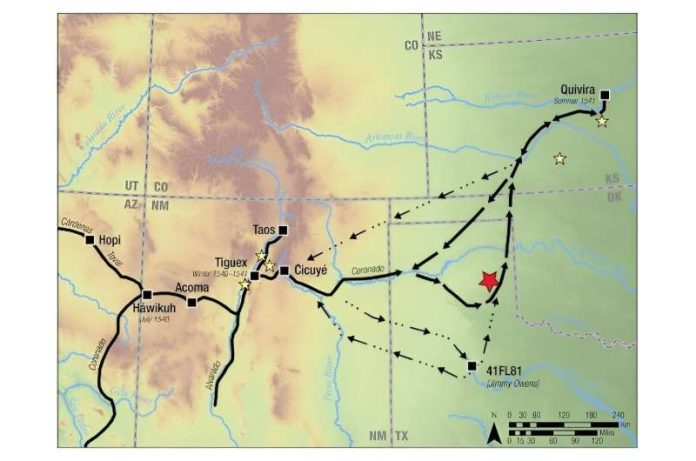
In the rugged terrains of the Texas panhandle, a small obsidian blade, merely over 5 centimeters in length, holds stories of adventure, exploration, and cultures intertwining over 470 years ago.
For SMU anthropologist Matthew Boulanger, this artifact is more than just a piece of stone; it’s a window into the epic journey of Francisco Vasquez de Coronado and his quest for a mythical city of gold.
Coronado’s expedition, a significant event in the history of North American exploration, spanned across what are now the states of Texas, New Mexico, Arizona, Oklahoma, and Kansas.
Boulanger’s fascination with the blade stems from its potential link to this expedition, particularly because of its material origin from Central Mexico’s Sierra de Pachuca, a region known for its obsidian tool production up until the Spanish conquest.
The blade’s journey to the Texas panhandle is a mystery that Boulanger explores with a combination of scientific analysis and historical investigation.
Spectrometer analysis confirms the obsidian’s geographical origins, aligning with the routes taken by Coronado’s expedition, which included indigenous people from Mexico known to have used such materials for their cutting tools.
This artifact represents a tangible connection to the past, suggesting the presence of Coronado’s expedition in the Texas panhandle, a region far from the mountain ranges of Central Mexico.
Boulanger’s research, published in the Journal of the North Texas Archeological Society, carefully pieces together the evidence, ruling out possibilities of a hoax and reinforcing the blade’s authenticity as a relic of this historical journey.
The story of the blade’s discovery adds another layer of intrigue. Found by Lloyd Erwin during his childhood on his family’s ranch near McLean, Texas, the artifact was part of a larger collection of historical items.
It wasn’t until Erwin’s daughter-in-law sought authentication from Boulanger that the blade’s true significance came to light.
The possibility of the blade being a part of a trade network or a deliberate hoax was considered but ultimately dismissed in favor of its genuine discovery and connection to the Coronado expedition.
This conclusion opens up fascinating avenues for further archaeological exploration and evidence gathering, potentially offering more insights into the routes and impacts of early explorers and the indigenous peoples who journeyed with them.
Boulanger’s advice to artifact collectors to document their finds with modern technology like GPS coordinates emphasizes the importance of every piece of history, no matter how small, in piecing together the vast puzzle of our past.
The obsidian blade, a seemingly inconsequential object, thus serves as a crucial piece of evidence in understanding the complex tapestry of human movement, interaction, and the relentless pursuit of myth and legend across the landscapes of North America.
Copyright © 2024 Knowridge Science Report. All rights reserved.



